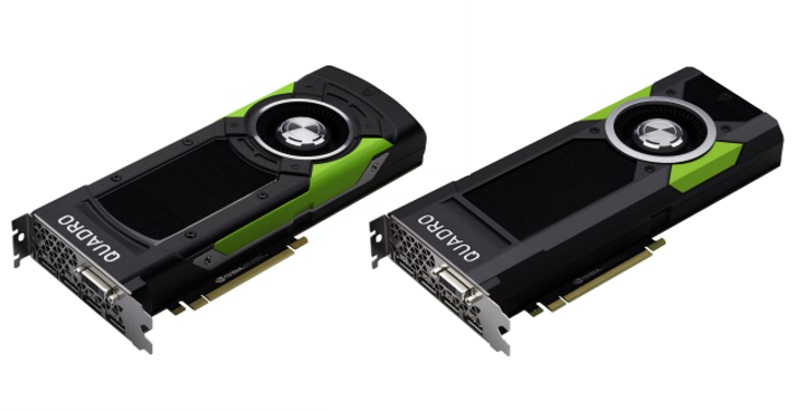- Home
- Laptops
- Laptops News
- Nvidia Debuts 'Pascal' Quadro P6000 and P5000 for VR and Design
Nvidia Debuts 'Pascal' Quadro P6000 and P5000 for VR and Design

The flagship Quadro P6000 and slightly lower-spec P5000 were launched at the ongoing SIGGRAPH conference in Anaheim, California; the world's foremost annual convention of computer graphics experts. Along with its new hardware, Nvidia also showed off a new 360 Video SDK aimed at helping creators who work with multiple 4K video streams such as those created by multi-camera rigs for 360 video, along with more robust Mental Ray support and updates to the Nvidia Optix ray tracing engine and Iray plugin.
Nvidia says its new Quadros are targeted at game and VR experience creators as well as those in the more traditional fields of scientific visualisation, big data, engineering, architecture, and medical research.
The more powerful Quadro P6000 is a full-featured GP102 chip with 3840 parallel processing cores. Total throughput is rated at 12 Teraflops and maximum power consumption is 250W, all of which is consistent with the specs of the new Titan X. The Quadro P6000 is outfitted with 24GB of GDDR5X RAM, with 9Gbps of bandwidth, and unlike the more consumer-oriented Titan X, this card will support ECC memory. However, according to AnandTech, double-precision FP64 operations are not specifically accelerated and will happen at 1/32 speed.
The Quadro P5000 is based on the same GP104 GPU as the GeForce GTX 1080 and 1070, with 2560 processing cores and 16GB of GDDR5X RAM at the same 9Gbps speed. TDP for this card is 180W. Clock speeds have not been announced for either card yet yet, and neither have performance targets or comparisons with the previous Maxwell generation M6000 and M5000.
Each card can drive four monitors at 5K resolution and 60Hz or four 4K monitors at 120Hz. Pascal's signature simultaneous multi projection (SMP) and async compute balancing features are also supported. Pricing was not disclosed at the event, but the two cards should be available in October.
The launches come hot on the heels of Nvidia's rapid Pascal deployment, which started with the high-performance P100 accelerator for big data. The consumer-focused GeForce GTX 1080, 1070 and 1060 cards followed in rapid succession, and the new Titan X was unveiled only a few days ago. This is the quickest succession of new launches in Nvidia's recent history, indicating that GPU production is in full swing with high yields.
Get your daily dose of tech news, reviews, and insights, in under 80 characters on Gadgets 360 Turbo. Connect with fellow tech lovers on our Forum. Follow us on X, Facebook, WhatsApp, Threads and Google News for instant updates. Catch all the action on our YouTube channel.
Related Stories
- Samsung Galaxy Unpacked 2025
- ChatGPT
- Redmi Note 14 Pro+
- iPhone 16
- Apple Vision Pro
- Oneplus 12
- OnePlus Nord CE 3 Lite 5G
- iPhone 13
- Xiaomi 14 Pro
- Oppo Find N3
- Tecno Spark Go (2023)
- Realme V30
- Best Phones Under 25000
- Samsung Galaxy S24 Series
- Cryptocurrency
- iQoo 12
- Samsung Galaxy S24 Ultra
- Giottus
- Samsung Galaxy Z Flip 5
- Apple 'Scary Fast'
- Housefull 5
- GoPro Hero 12 Black Review
- Invincible Season 2
- JioGlass
- HD Ready TV
- Laptop Under 50000
- Smartwatch Under 10000
- Latest Mobile Phones
- Compare Phones
- OnePlus Ace 6T
- OPPO A6x 5G
- Samsung Galaxy Z TriFold
- Poco F8 Ultra
- Poco F8 Pro
- Huawei Mate 80 RS Master Edition
- Huawei Mate 80 Pro Max
- Huawei Mate 80 Pro
- Asus ProArt P16
- MacBook Pro 14-inch (M5, 2025)
- Poco Pad M1
- Poco Pad X1
- Just Corseca Skywatch Pro
- Honor Watch X5
- Acerpure Nitro Z Series 100-inch QLED TV
- Samsung 43 Inch LED Ultra HD (4K) Smart TV (UA43UE81AFULXL)
- Asus ROG Ally
- Nintendo Switch Lite
- Haier 1.6 Ton 5 Star Inverter Split AC (HSU19G-MZAID5BN-INV)
- Haier 1.6 Ton 5 Star Inverter Split AC (HSU19G-MZAIM5BN-INV)

















